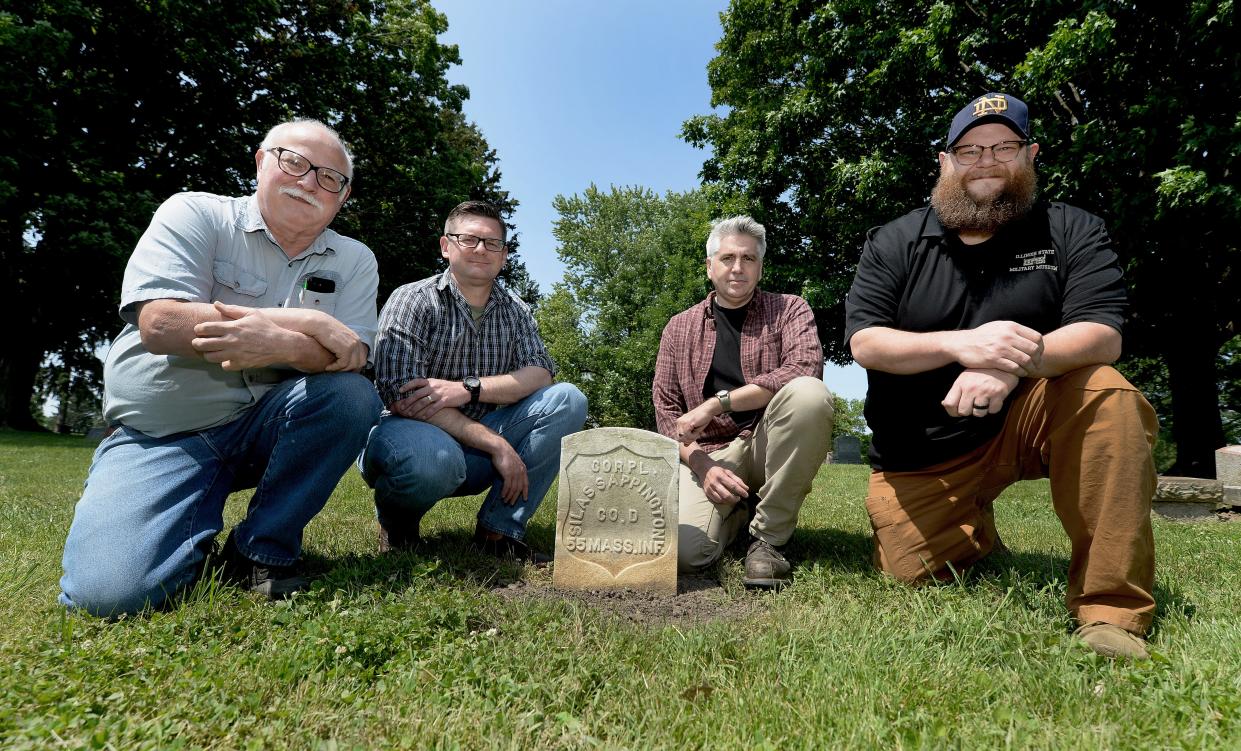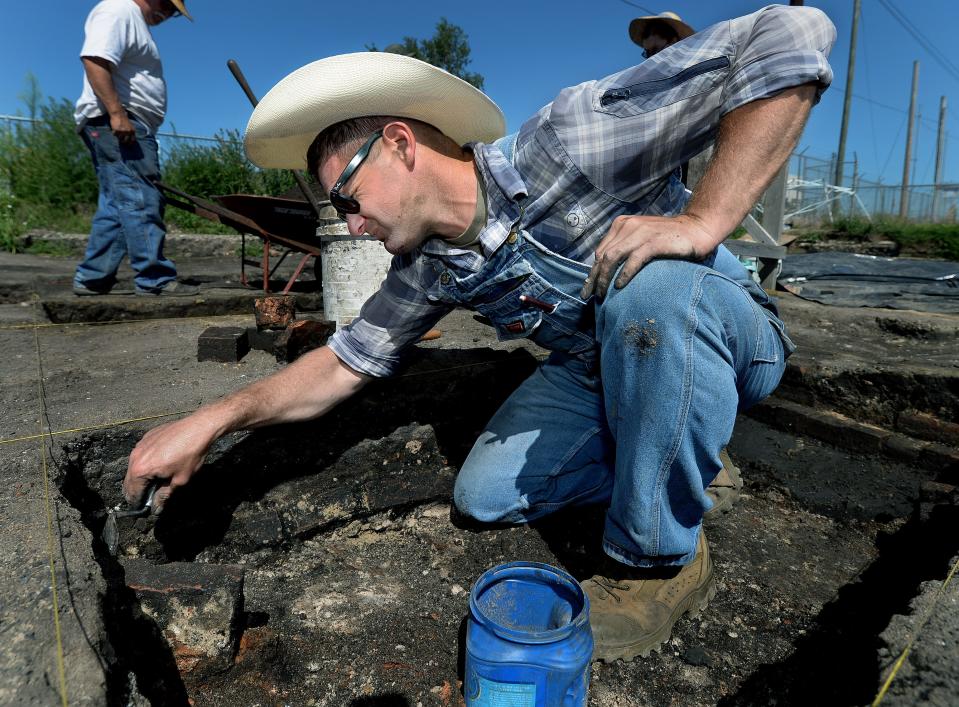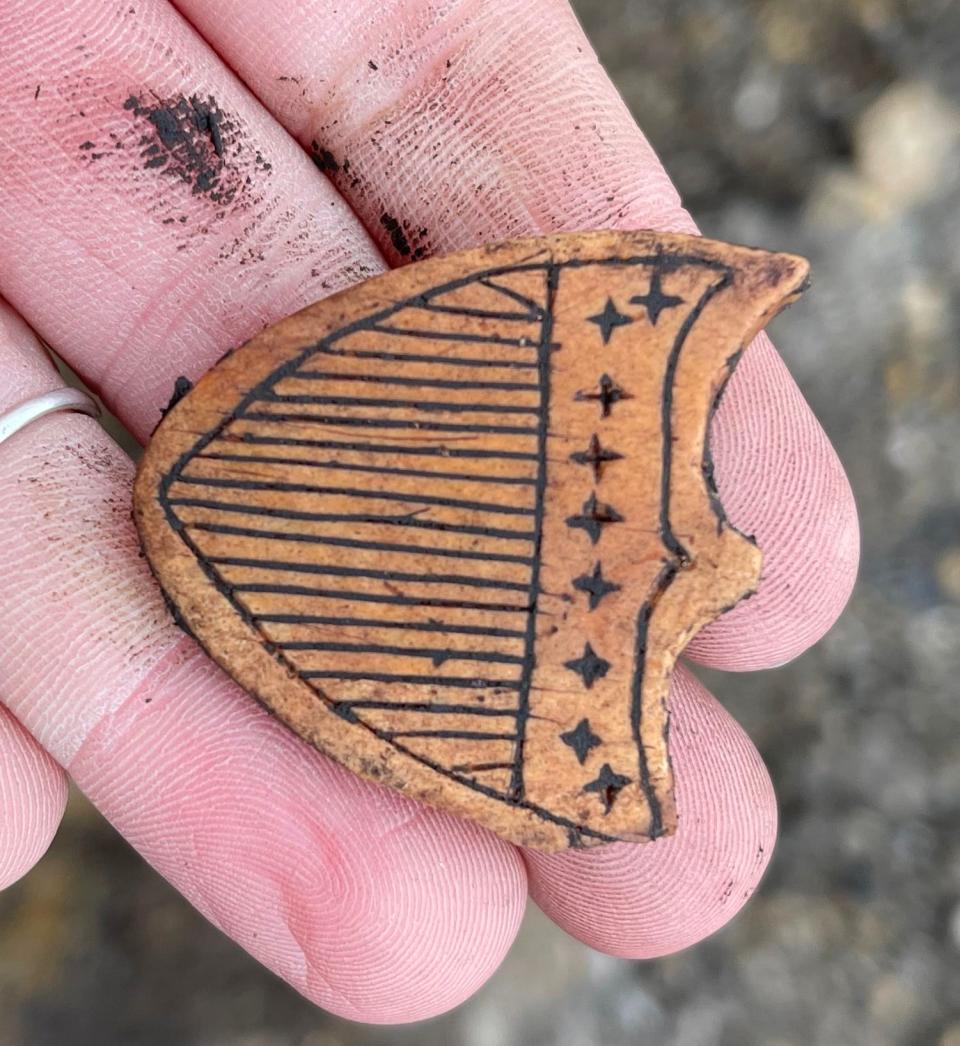'The proper respect': Group looks to restore marker of Black Civil War veteran

It began with the recovery of several Civil War era military artifacts, including J-hooks, associated with soldiers' knapsacks, uniform buttons and a Union shield hand carved out of bone last summer.
That's when Floyd Mansberger of Fever River Research and Paul Golladay, who has helped Mansberger for two-plus decades, were excavating a home that once belonged to David Sappington in the 300 block of North 10th Street.
The excavation was part of the 10th Street rail project, and the Sappington house was to the north and east of several house sites now being considered for a proposed national memorial commemorating the 1908 Race Riot in Springfield.
More: Budzinski to speak at Memorial Day ceremony at Camp Butler; public pools opening
The military artifacts clued Golladay, an officer candidate school course manager for the 129th Regional Training Institute in Springfield, into Silas Sappington, another one-time resident of the 10th Street home, and believed to be a nephew of David Sappington.
Silas Sappington, sometimes referred to as "Cyrus" or "Cy," Golladay further learned, served in the 55th Massachusetts Volunteer Infantry, an all-Black overflow regiment of the 54th Massachusetts, depicted in the Civil War movie "Glory," and mostly lived in Springfield after his discharge in 1865 until his death in 1922.
Curiosity eventually led Golladay to Section 24 of Oak Ridge Cemetery where he found Sappington's headstone, then sunken and showing its age. At one point, it was leaning so far forward, Golladay said, he had to lay on the ground and look up even to read Sappington's name.
The headstone was ground supported, meaning there was no base and no footing, he said.
Now history is being reset, literally.

Just before Memorial Day, Oak Ridge Cemetery workers recently straightened the marker, which was erected in 1925, and also poured crushed limestone eight inches down in the ground to give it a solid base, said the cemetery's interim executive director, Michael Lelys. Crushed limestone, with moisture, solidifies over time, he pointed out, making it almost as good as concrete.
Golladay, with assistance from Mansberger and Christopher Stratton, also from Fever River, and Adam Krall from the Illinois State Military Museum, will further tend to the marker during a work session at the cemetery on Sunday.
To spruce up the marker's readability - the white marble headstone is "a magnet" for lichen and moss, Golladay explained - they are using an inert, organic cleaning agent recommended by the National Park Service.
Technically, markers like Sappington's are property of the federal government, so before any work began, Golladay had to get the approval of the Department of Veterans Affairs and the National Cemetery Association along with the blessing of Lelys.
In many cases of Civil War veterans, like Sappington, Golladay said, no photographs of them survive nor are there other mementoes, like letters from the battlefront.

"For many of these soldiers, and this is nationwide, this government-provided marble tablet is the only thing to remind us they existed," he said.
Why did Sappington end up at Oak Ridge?
How Sappington ended up buried at Oak Ridge, as opposed to Camp Butler near Riverton, which was created in 1862 and was one of the first national cemeteries, is unclear, admitted both Golladay and Mansberger.
Sappington's second wife, Jane “Jennie” (Eskew) Sappington, who died in 1924, is buried in a separate grave just feet away from him. The couple's only child, Walter, who died at age 7 in 1880, is buried at Oak Ridge.
The connection could have been to Abraham Lincoln's being buried in the cemetery, Golladay offered, or the fact that the cemetery had designated areas for Black populations, including Block 24 and Block 5.
There is at least one other member of the 55th Massachusetts, Augustus "Gustus" George, buried in Block 24, along with other military veterans. Benjamin See, also with the 55th Massachusetts, is buried in the Grand Army of the Republic (GAR) Mound at the cemetery.
![Director Floyd Mansberger of Fever River Research goes through some of the artifacts that have been unearthed during the dig of the 1908 Race Riot site at Fever River Research in Springfield, Ill., Friday, February 19, 2021. The items show the soot from the fires that destroyed forty black homes and 15 black-owned businesses during the 1908 Race Riot. [Justin L. Fowler/The State Journal-Register]](https://s.yimg.com/ny/api/res/1.2/Hrf_iceawboLyPeWVPR0sQ--/YXBwaWQ9aGlnaGxhbmRlcjt3PTk2MDtoPTYzNA--/https://media.zenfs.com/en/the-state-journal-register/fcbbfbda5c7d6dc94d5467c39c31214c)
The Illinois State Journal, a forerunner to The State Journal-Register, detailed that two Springfield men, Robert Wright and Simeon Buckner Osby Sr., who were members of a special committee of Spanish War Veterans, procured headstones for Sappington and other Black Springfield veterans.
Wright lived in the 10th Street neighborhood close to Sappington where Mansberger said they uncovered some of Wright's war medals during an earlier excavation. Osby was a successful Black attorney in Springfield, Mansberger said.
Who was Silas Sappington?
Mansberger and Golladay were able to put together some information about Sappington's life, mostly through U.S. Census records and city directories, but also via newspaper accounts and army records.
Sappington's obituary suggested that he was born in Franklin County, Missouri, in 1843 to Nancy Sappington. His father may have been Silas Sappington Sr.
According to census records, David and Elijah Sappington, perhaps uncles of Silas Sappington, moved to Springfield around 1860, but it isn't clear if Silas Sappington had a connection to Springfield before enlisting in the war as a private at Camp Meigs in Readville, Massachusetts on May 29, 1863. One clue he might have been was a listing for “James Smith, Springfield, Ills." in Sappington's military papers.
"Why or how he decided to go to Massachusetts is a good question," Golladay said. "Out of the 55th Massachusetts, there was a significant number who had come from Missouri."
The 55th Massachusetts first saw battle at Fort Wagner in North Carolina, where a protracted siege of trench warfare resulted in its fall.
The regiment remained in the coastal area between Charleston and Florida before being transferred to northernFlorida in early 1864, only to return to the vicinity of Charleston later that year. In late 1864, the regiment joined with Gen. William Sherman’s forces as they marched through Georgia and the Carolinas and played a significant role in the Battle of Honey Hill, South Carolina, where the regiment suffered heavy losses.
In February 1865, the regiment was one of the first of the Union forces to enter the captured city of Charleston, and it remained there the next several months as an occupying force.
More: Municipal Band starts 87th season with concerts at Duncan Park, ALPLM, Edwards Place
Sappington was mustered out of military service on August 29, 1865. Military papers suggest that he was mustered out in Charleston, but regimental records suggest that the regiment was transported back to Boston.
Sappington shows up in Springfield in October 1865, joining his mother there. An 1866 city directory listed him as a cook at the St. Nicholas Hotel. That fall, he married Harriett Petters, though no information is known about her or when the marriage was dissolved.
A second marriage to Jennie Eskew in 1872 lasted 50 years.

In city directories, Sappington shows up as a cook at the hotel or the county jail. Golladay said there's an indication that he was residing in the house near the 10th Street tracks between Madison and Rutledge or Carpenter, then later on on 14th Street.
"You have this veteran who served gallantly who comes to Springfield," Mansberger said. "He keeps his head down and is involved in a couple of civic and military organizations."
Mansberger said when he got involved in the archaeology of the 10th Street area, there were some preconceived notions.
"We got the feeling that this was a rundown Black neighborhood that the mob attacked (in 1908)," he said. "The archaeology has really shown that this neighborhood by 1860 was starting to become a small enclave of socially elite Blacks of Springfield and the Sappington family is right there among them."
That centered around, he said, the Rev. Henry Brown, an African Methodist Episcopal preacher who knew Abraham Lincoln and led "Old Bob," the Lincoln family horse, in President Lincoln’s funeral procession.
Golladay said there likely will be other tombstone projects at Oak Ridge after Sappington's marker is restored.
Lelys said he was grateful for the assistance.
"We are always appreciative of any organization that comes in and assists with us because it's just too massive for us to do everything," he said.
"I feel good to be with Paul to see that these individuals get the proper respect they deserve," Mansberger added. "They were veterans like every other veteran and the tombstones need some upkeep and I'm proud to do it."
The 114th Illinois Volunteer Infantry Regiment Reactivated will hold a wreath-laying ceremony at the Grand Army of the Republic Mound (Block 10) at Oak Ridge Cemetery at 9 a.m. Monday.
Contact Steven Spearie: 217-622-1788, sspearie@sj-r.com, twitter.com/@StevenSpearie.
This article originally appeared on State Journal-Register: A group is restoring the marker of a Civil War veteran in Springfield

